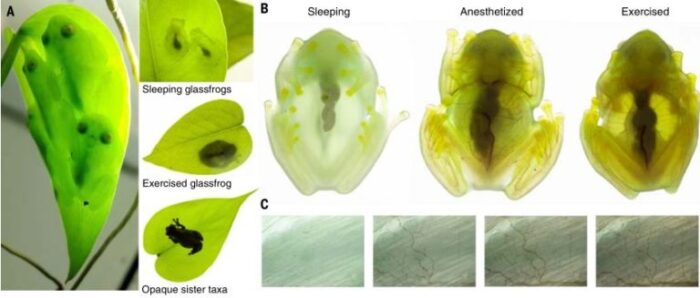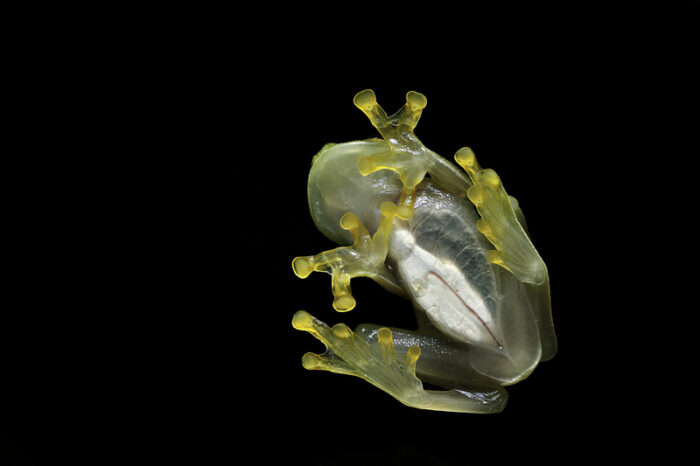Depending on your point of view, glass frogs are either amazing or a little creepy. Or maybe it's both!
These remarkable amphibians are known for their translucent (mostly see-through) skin and muscles. This allows light to pass through their tiny bodies, making for some truly special camouflage. Especially when hanging out under a green leaf, their favourite hiding place! It also allows us to see inside their bodies.
But while these frogs are 'clear', we can still see their shape and their organs. This is thanks to that very important fluid that flows through the organs and all throughout their bodies. Blood.
The frog is awake and active at night (glass frogs are nocturnal). But during the day, when sleeping under a leaf, their blood can cast a frog-shaped shadow, which tips off predators that a tasty snack can be found there.
Sleeping clearly
But a new study by a team of scientists led by Carlos Taboada of Duke University has revealed how glass frogs get around the problem.
As they sleep, they drain the blood from the rest of their body and store it all in their liver. Now instead of seeing a 'frog blob', all that can be seen is a tiny dark teardrop shape.
Take a look below.

These images show the difference between active and sleeping glass frogs. The image of a 'sister taxa', is of a similar frog species. It shows you what an ordinary frog would look like trying to hide under a leaf. Pretty big differences, right? (Taboada et al, Science 2022)
The team studied the frogs as they were active and sleeping. Once sleeping, they became almost completely clear.
But isn't blood important?
This stunt is stunning for a few reasons. How do these animals survive without blood flowing through their bodies?
For example, if blood stops flowing to a part of our bodies, we quickly lose feeling there, as well as the ability to move that body part. (This is when our arm or foot 'goes to sleep'.)
But the glass frog's blood stops flowing to organs, like its lungs and heart. If that happens to most other animals, the result is deadly.
How glass frogs survive is a real mystery!
Not a clot
Then there is another question. How do these frogs avoid clotting?
Clotting happens when red blood cells get bunched up together. They harden and form a barrier. This natural reaction is how scabs are made—it is our body's way of closing a wound and making sure that blood is not lost.
But if blood clots happen inside the body, they can be deadly because they stop the blood from flowing around. So even if an animal could survive sleeping with its blood stored in one area, the blood clots that would form would mean that the blood would not return to the rest of the body once that animal woke up.
And yet with the incredible glass frog, all of its blood returns to the rest of its body just seconds after it wakes up. How?
Amazing potential
Researchers only know that the glass frog does it. Not how. Not yet.
Finding out how could be a huge scientific and medical breakthrough. Blood clots in humans can be dangerous. If glass frog DNA has a secret to prevent clots, it could actually save lives!
Until then, we'll just have to be content knowing that these little miracle amphibians are yet another example of nature's ability to surprise and amaze us.
Check out this video below from ScienceAlert that collects footage from the researchers' study.
 Peek-a-boo! The see-through belly of an active glass frog. Amazingly, they get even more see-through as they sleep! (ID 14101681 © Dirk Ercken | Dreamstime.com)
Peek-a-boo! The see-through belly of an active glass frog. Amazingly, they get even more see-through as they sleep! (ID 14101681 © Dirk Ercken | Dreamstime.com)









